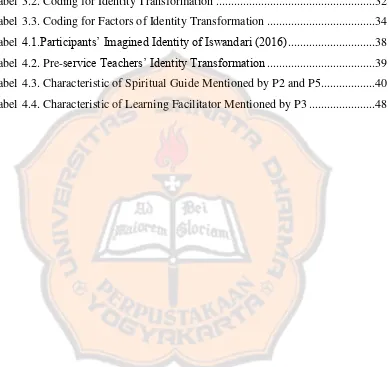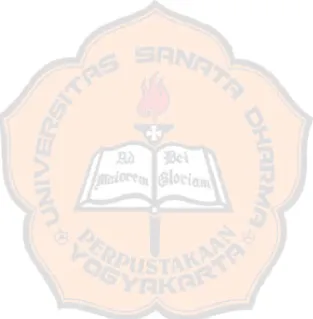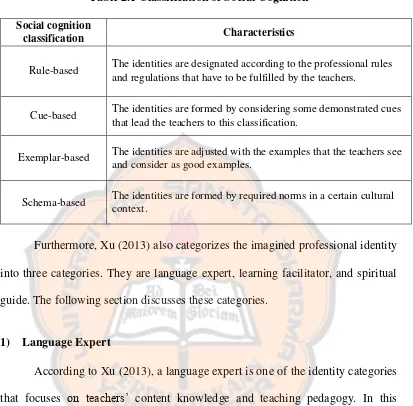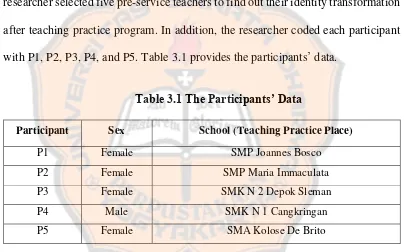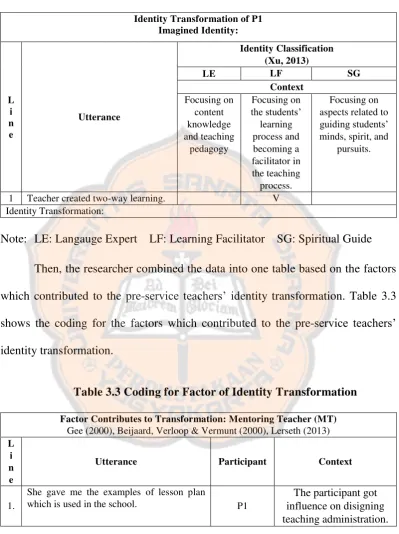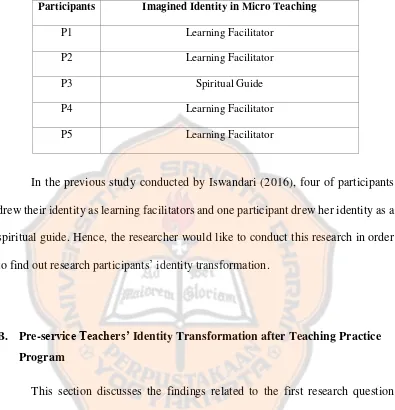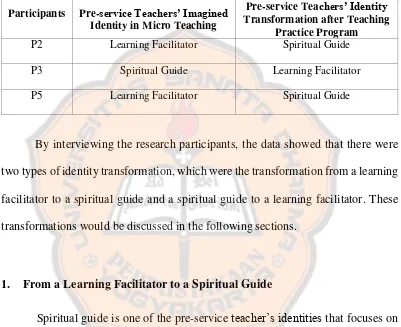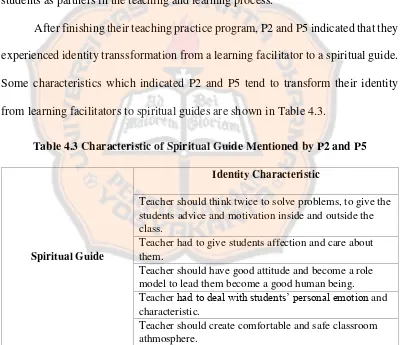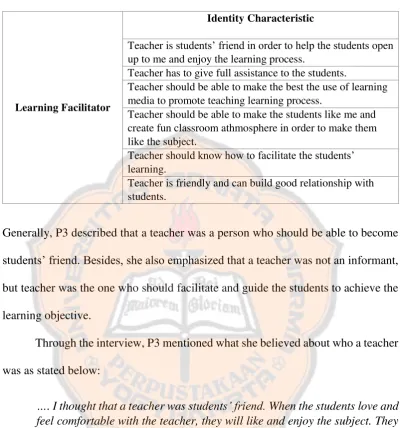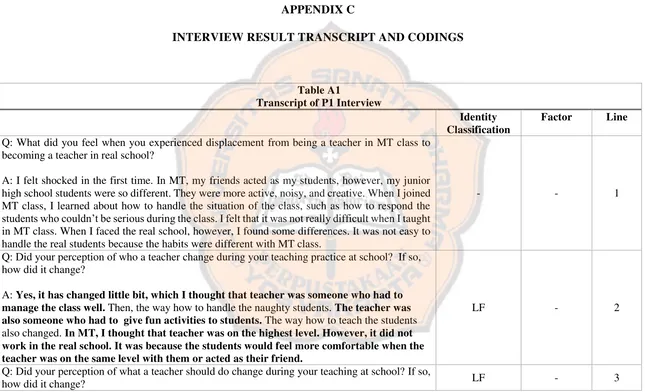A STUDY OF EFL PRE-
SERVICE TEACHERS’ IDENTITY
TRANSFORMATION ON THE DEVELOPMENT OF THEIR
PROFESSIONAL IDENTITY
A
SARJANA PENDIDIKAN
THESIS
Presented as Partial Fulfillment of the Requirements to Obtain the Sarjana Pendidikan Degree
in English Language Education
By
Elizabet Afreilyanti Student Number: 131214052
ENGLISH LANGUAGE EDUCATION STUDY PROGRAM DEPARTMENT OF LANGUAGE AND ARTS EDUCATION FACULTY OF TEACHERS TRAINING AND EDUCATION
SANATA DHARMA UNIVERSITY YOGYAKARTA
i
A STUDY OF EFL PRE-
SERVICE TEACHERS’ IDENTITY
TRANSFORMATION ON THE DEVELOPMENT OF THEIR
PROFESSIONAL IDENTITY
A
SARJANA PENDIDIKAN
THESIS
Presented as Partial Fulfillment of the Requirements to Obtain the Sarjana Pendidikan Degree
in English Language Education
By
Elizabet Afreilyanti Student Number: 131214052
ENGLISH LANGUAGE EDUCATION STUDY PROGRAM DEPARTMENT OF LANGUAGE AND ARTS EDUCATION FACULTY OF TEACHERS TRAINING AND EDUCATION
SANATA DHARMA UNIVERSITY YOGYAKARTA
vi ABSTRACT
Afreilyanti, Elizabet. (2017). A Study of EFL Pre-service Teachers’ Identity Transformation on the Development of Their Professional Identity. Yogyakarta: English Language Education Study Program, Sanata Dharma University.
The fact that Indonesia really needs professional teachers is undiniable. It is because professional teachers are one of the important elements in creating high quality of education. In order to draw up professional teacher candidates, teaching practice program which is held by English Language Education Study Program (ELESP) becomes the process to train pre-serice teachers to be professional English teachers. During this program, ELESP pre-service teachers begin to construct their teacher identity with various image of themselves as teachers. Besides, during the process, the ELESP pre-service teachers might also transform their identity. In addition, there are also some factors which contribute to their identity transformation during the teaching practice program.
With regard to this phenomenon, this study addressed two research questions. The first was “What identity transformations do EFL pre-service teachers experience after finishing teaching practice program?” and the second was “What are the factors which contribute to EFL pre-service teachers’ identity transformation after finishing teaching practice program?” Thus, the researcher would like to find out pre-service teachers’ identity transformation and the factors which contributed to the transformation. This research was a qualitative research. It employed interview guidelines to understand the pre-service teachers’ experience during the teaching practice program.
Besides, the data were mainly from the statements or utterances said by the pre-service teachers on the interviews. Besides, the identity transformation was analyzed by considering the previous research’ data conducted by Iswandari (2013). Then, the data were analyzed using Creswell’s (2009) qualitative data method. Afterward, the analyzed data were classified based on the professional imagined identity by Xu (2013) to answer the first research question. Then, the researcher employed Beijaard et al. (2000), Gee (2000), and Lerseth’s (2013) theories to answer the second research question.
vii ABSTRAK
Afreilyanti, Elizabet. (2017). A Study of EFL Pre-service Teachers’ Identity Transformation on the Development of Their Professional Identity. Yogyakarta:
Program Studi Pendidikan Bahasa Inggris, Universitas Sanata Dharma
Guru yang profesional sangat diperlukan Indonesia sebagai salah satu elemen untuk menciptakan pendidikan yang berkualitas tinggi. Dalam rangka mempersiapkan calon – calon guru yang profesional, praktik program mengajar yang diselenggarakan oleh Program Studi Pendidikan Bahasa Inggris menjadi sarana bagi mahasiswa PPL untuk mempersiapkan dirinya sebagai guru bahasa Inggris yang profesional. Dalam menjalani program tersebut, para mahasiswa PPL Pendidikan Bahasa Inggris mulai membangun identitas diri mereka dengan berbagai gambar tentang diri mereka sebagai seorang guru. Namun, saat menjalani program tersebut, para mahasiswa PPL juga mungkin mengalami perubahan identitas diri mereka sebagai seorang guru. Adanya perubahan identitas tersebut juga dikarenakan adanya beberapa faktor yang mempengaruhi para mahasiswa PPL selama menjalani program praktik mengajar tersebut.
Penelitian ini didasarkan pada fenomena tersebut dan dilakukan untuk menjawab dua rumusan masalah. Pertama, “Perubahan identitas apa yang dialami oleh para mahasiswa PPL setelah menyelesaikan praktik program mengajar?” dan kedua, “Faktor-faktor apa yang mempengaruhi perubahan identitas para mahasiswa PPL setelah menyelesaikan program praktik mengajar?” Berdasarkan dua rumusan masalah tersebut, peneliti ingin meneliti perubahan identitas yang dimiliki oleh para mahasiswa PPL dan faktor-faktor yang mempengaruhi perubahan identitas tersebut. Penelitian ini merupakan penelitian kualitatif. Wawancara digunakan dalam penelitian ini untuk memahami pengalaman para mahasiswa PPL selama menjalani program praktik mengajar.
Data penelitian berasal dari pernyataan atau ungkapan mahasiswa PPL pada saat wawancara. Perubahan identitas pada diri mereka juga dianalisis berdasarkan data pada penelitiannya sebelumnya yang dilakukan oleh Iswandari (2013). Data kemudian dianalisis menggunakan metode penelitian Creswell (2009). Data yang sudah dianalisis kemudian dianalisis berdasarkan katagori imagined identity menurut Xu (2013). Teori-teori menurut Beijaard et al. (2000), Gee (2000), dan Lerseth (2013) digunakan untuk menjawab pertanyaan kedua.
Hasil penelitian menunjukkan bahwa terdapat tiga dari mahasiswa PPL yang mengalami perubahan identitas yaitu dari learning facilitator menjadi spiritual guide dan dari spiritual guide menjadi learning facilitator. Selain itu, peneliti juga menemukan adanya faktor-faktor yang mempengaruhi perubahan identitas tersebut, yaitu pengenalan diri, hubungan dengan para siswa, konsep dan teknik mengajar, dosen pembimbing lapangan dan guru pamong, tekanan, pengalaman mengajar, dan ilmu pengetahuan.
viii
ACKNOWLEDGEMENTS
First of all, I would like to extent my gratitute to Almighthy God for every single blessing in my life. I am so blessed and loved for He always knows what is best for me. I am so grateful that He arranges me to meet with people who are so helpful and cooperative during the process of writing this thesis.
Secondly, I would like to express my deepest gratitute to my advisor, Yuseva Ariyani Iswandari, S.Pd., M.Ed., for her help, guidance, great patience, and motivation. I thank her for the time in every consultation time in between her busy and tight schedule. Additionally, I thank her for helping me validate my research. Besides, I would like to thank Paulus Kuswandono, Ph.D. and Made Frida Yulia, M.Pd. for their suggestions and feedback related to my thesis. Then, I would especially like to thank my research participants, specially for their time and patience. I am also thankful to Yohanes Maria Restu for being my discussion partner during the research as well as helping me validate my research.
ix
and helping me validate my thesis too. Last but not least, my great gratitude goes to everyone who cannot be mentioned one by one who has helped, guided, supported, and shared his or her time with me, especially during the process of writing this thesis.
x
TABLE OF CONTENTS
TITLE PAGE ... i
APPROVAL PAGES ... ii
STATEMENT OF WORK’S ORGINALITY ... iv
PERNYATAAN PERSETUJUAN PUBLIKASI ... v
ABSTRACT ... vi
ABSTRAK ... vii
ACKNOWLEDGMENTS ... viii
TABLE OF CONTENTS ... x
LIST OF TABLES ... xii
LIST OF FIGURES ... xiii
LIST OF APPENDICES ... xiv
CHAPTER I. INTRODUCTION ... 1
A. Research Background... 1
B. Research Questions ... 4
C. Research Significance ... 5
D. Definition of Terms ... 6
CHAPTER II. REVIEW OF RELATED LITERATURE ... 8
A. Review of Previous Study ... 8
B. Theoretical Description ... .9
1. Identity ... 9
2. Pre-service Teachers’ Indentity Transformation ... .11
3. Pre-service Teachers’ Profesional Identity Development ... .22
xi
CHAPTER III. RESEARCH METHODOLOGY ... 26
A. Research Method ... 26
B. Research Setting ... .27
C. Research Participants ... .27
D. Instrument and Data Gathering Technique ... .29
1. Human Instrument ... 29
2. Interview Guideline ... .30
E. Data Analysis Technique ... .30
CHAPTER IV. RESEARCH FINDINGS AND DISCUSSION ... 35
A. Previous Findings on Imagined Identity ... 35
B. Pre-service Teachers’ Identity Transformation after Teaching Practice Program ... .38
1. From a Learning Facilitator to a Spiritual Guide ... 39
2. From a Spiritual Guide to a Learning Facilitator ... .46
C. Factors of Pre-service Teachers’ Identity Transformation... .51
1. Major Factor of Pre-service Teachers’ Indentity Transformation ... 51
2. Minor Factors of Pre-service Teachers’ Identity Transformation... 59
D. Another Finding on Pre-service Teachers’ Identity Transformation ... .67
CHAPTER V. CONCLUSIONS AND RECOMENDATIONS ... 71
A. Conclusions ... 71
B. Recomendations ... .75
1. For ELESP Lecturers and English Teachers ... 75
2. Future Researchers ... .75
REFERENCES ... 77
xii
LIST OF TABLES
Tabel 2.1. Classification of Social Cognition ... 13
Tabel 3.1. The Participants’ Data ... 28
Tabel 3.2. Coding for Identity Transformation ... 32
Tabel 3.3. Coding for Factors of Identity Transformation ... 34
Tabel 4.1.Participants’ Imagined Identity of Iswandari (2016) ... 38
Tabel 4.2. Pre-service Teachers’ Identity Transformation ... 39
Tabel 4.3. Characteristic of Spiritual Guide Mentioned by P2 and P5... 40
xiii
LIST OF FIGURES
xiv
LIST OF APPENDICES
APPENDIX A ... 81
APPENDIX B ... 82
APPENDIX C ... 84
APPENDIX D ... 106
APPENDIX E ... 114
APPENDIX F ... 125
APPENDIX F ... 126
1 CHAPTER I
INTRODUCTION
This chapter consists of four parts. The first is the research background which includes the description of the topic and the reason why the topic is chosen. The second is research questions which present the formulation of problem to be discussed in a form of questions. The third is research significance which identifies the contribution of the study to the parties and the development of knowledge. The last part is the definition of terms which explains the key words of the study.
A. Research Background
Education is widely seen as one of the most important parts of social policy around the world. It is viewed as one of the key areas for increasing a nation building such as in competitiveness and social justice. Indonesia is no exception. Indonesia is currently in the middle of a period of convulsive reform supposedly aimed at achieving better education outcomes for human resources (Jalal, Samani, Chang, Stevenson, Ragatz, and Negara, 2009).
Professional teachers are one of the country pillars in realizing good quality
of education. Ministry of Education and Culture (2008) states that a teacher is the
main element in education system as one of the ways to create good quality of
education. It is because a teacher has some important roles. One of them is to
become the main element who helps students learn during the learning process.
Therefore, it is clear that a teacher is the central of renewal and development of education quality.
In accordance to this, English Language Education Study Program (ELESP) is one of study programs in Sanata Dharma University which educates the students to become professional English teachers. According to Rohandi, Puji, Catur, Saverinus, Agustinus, and Christina (2012), in order to become English teacher candidates, the pre-service teachers need a training course that can teach basic skills and learn the material deeply in the form of simulation. There are two training courses that must be accomplished by all of ELESP students.
The first training course is Micro Teaching course which was taken in the sixth semester. Micro teaching is a course in which the pre-service teachers learn to manage the learning process for the first time (Rohandi et al., 2012). Micro teaching is a real teaching practice but it is not in a real situation at school. This course is aimed to train the pre-service teachers before they are going to the real situation and doing their teaching practice program at school.
Lapangan (PPL) is a program for the pre-service teachers to practice teaching, under the supervision of school teachers (Guru Pamong) to get the skills in giving the material. The pre-service teachers, in this case, do not only learn how to make a lesson plan, but they also get first hand experiences of how to teach the students in the real situation. Therefore, this is the basis of all the education courses as a pre-teacher profession. According to Rohandi (2012), the purpose of the teaching practice program is to know the social environment well in the school where the pre-service teachers do their teaching practice and to prepare them to be professional teachers.
Although the development of professional identity is most evident when teachers start working, their professional identity development begins during their pre-service education (Flores & Day, 2006; Walkington, 2005). Specifically, this study is related to the previous study which was conducted by Iswandari (2016). The study investigated pre-service teachers’ imagined identity in the Micro Teaching course. Pre-service teachers’ professional imagined identity refers to three categories namely a language expert, a language facilitator, and a spiritual guide. Therefore, the researcher would like to find out identity transformation that these pre-service teachers have after doing their teaching practice in real school setting. Finally, this study also aimed to find out the factors which influence their identity transformation on the development of professional identity.
Considering the phenomenon of identity transformation of ELESP pre-service teachers, the researcher proposed to study the pre-pre-service teachers’ identity and analyze the factors which contribute to the transformation. This study is also expected to provide some benefits, specially for pre-service teachers in order to help them become more aware of their identity transformation which develops their sense of professional identity.
B. Research Questions
Based on the research background above, the problems are formulated as follows:
2. What are the factors which contribute to EFL pre-service teachers’ identity transformations after finishing teaching practice program?
C. Research Significance
By considering this research, the researcher expects this research to provide benefits for:
1. EFL Pre-service Teachers
The findings of this research will become good reflection for pre-service teachers’ professional identity development. The pre-service teachers are expected to be aware of their identity transformation and the factors that contribute to their identity transformation in order to develop their professional identity in the learning process of becoming an English teacher.
2. English Language Education Study Program
The main goal of teaching practice is to train the pre-service teachers to be ready for becoming professional teachers. By considering this main goal, the findings of this research could become reflection and evaluation for English Language Education Study Program to be better in educating the students as future teachers.
3. For Future Researcher
Hence, future researchers will have an early description about identity transformation and the factors that contribute to the development of teacher’s professional identity.
D. Definition of Terms
This study concerns with some variables. Therefore, it is significant to define some variables to make the concern clearer and to avoid misunderstanding. The terms that are needed to be defined in this research are as the following:
1. EFL Pre-service Teachers
2016/2017 Accademic Year.
2. EFL Pre-service Teachers’ Identity Transformation
Since pre-service teachers are still in the state of becoming a teacher, they are still in the process to construct their teacher identity. Rodger and Scott (2008) state that “becoming a teacher means transforming an identity, adapting personal understandings and ideals to institutional realities, and deciding how to express themselves in classroom activity” (as cited in Caruana, 2011, p. 1). Hence, during the process, pre-service teachers’ identity is always in formation process in which they might transform their identity and adapt their understanding to the new realities. In this study, identity transformation refers to change of pre-service teachers’ identity after doing teaching practice in the real school setting. In addition, the transformation is indicated by some characteristics mentioned by the pre-service teachers.
3. Pre-service Teachers’ Professional Identity
8 CHAPTER II
REVIEW OF RELATED LITERATURE
This chapter reviews theories which are relevant to this research. There are three main parts in this chapter, namely review of previous study, theoretical description and theoretical framework. The review of previous study provides brief explanation of previous research. Then, the theoretical description provides explanation of underlying theories related to pre-service teachers’ identity transformation and the factors which contribute to the transformation. Then, theoretical framework discusses the theories which are set as the framework of this study to answer the formulated research questions.
A. Review of Previous Study
Iswandari (2016) examined 19 EFL pre-service teachers in her class namely Micro Teaching. Furthermore, she used reflective journals to find out their imagined professional identity by employing categories of professional identity by Xu (2013), namely language expert, language facilitator, and spiritual guide. The result showed that the three categories appeared in her study in which she found that there were 12 language facilitators, 5 language experts, and 2 spiritual guides.
B. Theoretical Description
In this section, the study elaborates the theories of identity. The researcher employs definition of identity by experts in order to examine the identity transformation of EFL pre-service teachers and the factors which contribute to the transformation.
1. Identity
Identity is related to a person’s uniqueness or personal characteristics which make himself or herself different from others. Besides, identity is also related to how someone acts. In this section, the definition of identity and EFL pre-service teacher’s identity will be discussed.
a. Definition of Identity
Identity deals with self-understanding and self-portrait. According to
Beijaard (1995), identity has been defined as “who or what someone is, the various
meanings people can attach to themselves, or the meanings attributed by others” (as
identity as how someone describes himself or herself to himself or herself and to other people. Additionally, identity involves an ongoing process. In relation to this, Lasky (2005) also states that identity is gradually formed and shaped over the process. In brief, it can be concluded that identity is self-understanding that defines who someone is. Further, identity also involves an ongoing process of incorporating someone with his or her profession.
b. EFL Pre-service Teachers’ Identity
Learning and teaching a language to students at the same time is not easy. This is what EFL pre-service teachers should do while they are doing their job as a teacher. In relation to this, Hamerness, Darling-Hammond, Grossman, Rust, and Shulman (2005) state that becoming a EFL teacher is complex. In addition, it is because English is considered as a foreign language in Indonesia. Consequently, in order to be an English teacher, pre-service teachers should learn the language and know how to teach the language as English is not the first language in Indonesia.
While they are in the learning process which prepares them as future teachers, however, pre-service teachers are always in a state of becoming a teacher (Danielewicz, 2001). In this process of becoming a teacher, the pre-service teacher may construct new identity or transform her or his identity, adapt personal understandings to realities, and decide how to express herself or himself in classroom activity (Rodgers & Scott, 2008). Besides, in defining pre-service
teachers’ identity, Gee (2000) emphasizes that identity is related to what pre-service teachers believe about who a teacher is. Furthermore, Gee clearly states that what pre-service teachers believe about who a teacher is is connected with how a teacher acts. In relation to this, Beijaard et al. (2000) also define that analyzing what pre-service teachers believe about what a teacher does is lens in observing pre-pre-service
teachers’ identity. Hence, from this perspective, it can be concluded that EFL pre-service teachers need time to practice the knowledge or the theory they have gotten during the courses. Furthermore, this teaching practice program helps them develop their professional identity as teachers, although they are still in the state of becoming a teacher.
2. Pre-service Teachers’ Identity Transformation
discuss the pre-service teachers’ identity transformation and the factors that contribute to the transformation.
a. Pre-service Teachers’ Identity Transformation on Imagined Identity
While doing their teaching practice, many pre-service teachers still experience a reality shock during the transition from the first to the next teaching practice due to unpredictable educational contexts (Xu, 2012). In this case, pre-service teachers start their first teaching practice with their imagined identities. Specifically, the imagined identity is individual’s imagination, as described by Wenger (1998):
... a process of expanding our self by transcending our time and space and creating new images of the world and ourselves. Imagination in this sense is looking at an apple seed and seeing a tree. It is playing scales on a piano, and envisioning a concert hall (as cited in Xu, 2013, p. 20).
Imagination, in this case, is the way people may create unlimited images of themselves based on their unlimited experiences. Besides, Xu (2013) argues that social cognition theories are used to analyze imagined identity features. Moscovici
(2000) mentions that “social cognitions, of which professional is one kind, can be
Table 2.1 Classification of Social Cognition Social cognition
classification Characteristics
Rule-based The identities are designated according to the professional rules and regulations that have to be fulfilled by the teachers.
Cue-based The identities are formed by considering some demonstrated cues that lead the teachers to this classification.
Exemplar-based The identities are adjusted with the examples that the teachers see and consider as good examples.
Schema-based The identities are formed by required norms in a certain cultural context.
Furthermore, Xu (2013) also categorizes the imagined professional identity into three categories. They are language expert, learning facilitator, and spiritual guide. The following section discusses these categories.
1) Language Expert
According to Xu (2013), a language expert is one of the identity categories that focuses on teachers’ content knowledge and teaching pedagogy. In this particular context, Xu notes that a language expert’s goal is focused on the teaching specific content to students by considering himself or herself as the main source of knowledge. Specifically, a language expert solely determines the goals, outcomes, methods of instruction, and evaluation of the class with little or no input from the students. In other words, the teacher is the only authority in the classroom.
(grammar) and fluent in speaking. Moreover, they are able to speak English well and fluently. In brief, it can be concluded that a language expert focuses more on
students’ great understanding of the material by considering herself or himself as the main source of knowledge.
2) Learning Facilitator
The next category is learning facilitator. Xu (2013) states that this category refers to the pre-service teacher who focuses on the students’ learning process and becoming a facilitator in the teaching learning process. In this case, a learning facilitator believes that teaching is more on giving students opportunity to undergo the process and get full assistance from the teacher. In a addition, as a learning facilitator, Xu emphasizes that a teacher can create a two-way learning condition because learning is not only from a teacher as the main source of knowledge. Specifically, a teacher as a learning facilitator commonly applies learner center practice. In accordance to this, Iswandari (2016) also argues that a learning
facilitator is often considered as a students’ friend. Furthermore, McCombs, Daniels and Perry (2008) also state that a teacher as a learning facilitator includes students in educational decision making, respects and encourages their diverse perspectives, and treat students as partners in the teaching and learning process.
allow the students to become actively engaged.
Besides, the next characteristic of learning facilitators is they tend to make best use of media in order to help the students achieve great understanding rather than explaining the material in the long time (Xu, 2013). This is in line with Naz and Akbar (2005), who clearly states that teaching learning media is a medium that a teacher uses to present lesson effectively. Hence, it leads a learning facilitator consider himself or herself as someone who facilitates the students in the teaching learning process.
In brief, a learning facilitator, in this particular context, refers to the pre-service teacher who is friendly and can build good relation with the students. Further, as a learning facilitator, they can create fun teaching learning activities by considering teaching learning media as the medium that can promote students’ understanding. Besides, a learning facilitator also emphasizes more on facilitating the students learning process rather than explaining the materials in front of the class.
3) Spiritual Guide
Another identity category is spiritual guide, which focuses on aspect related
to the “guiding students’ minds, spirit, and pursuits” (Xu, 2013, p. 82). In relation
Hence, as a spiritual guide, the pre-service teacher does not only focus on students’ knowledge and great understanding of the material, but also focus more on becoming a good model for the students.
Besides, a spiritual guide cares about students’ personality (Xu, 2013). In this case, a pre-service teacher who perceives his or her identity as a spiritual guide tends to act as a good listener inside and outside classroom. This is in line with Rubio (2009) who states that teachers must care about their students. In this case, caring about the students includes listening to the students about their particular life and or their personal problems. Furthermore, Stronge et al. (2004) also mention that a teacher who becomes a good listener, pays attention to, and shows understanding to the students through tenderness and patience, leads the students perceive effectiveness. It is because the teachers show their kindness, gentleness and encouragement. Hence, a spiritual guide cares about the students and tends to create comfortable atmosphere in order to make the students consider them as a safe and comfortable figure.
In conclusion, identity involves an ongoing process in which pre-service teachers might change their identity during the process. It is because pre-service teachers are always in the state of becoming a teacher. However, the identity transformation can be seen as a process in which pre-service teachers conform themselves during the process in order to develop their sense of professional identity.
b. Factors of Identity Transformation
Identity is an ongoing process which leads the pre-service teachers to adapt their understanding and transform their identity as a process in developing their professional identity. Beijaard, Verloop, & Vermunt (2000) argue that the pre-service teachers deal with some factors that contribute to their identity transformation during this ongoing process. In relation to this, one of the factors might be external factor which refers to the people who are in contact with the pre-service teachers. Lerseth (2013) argues that mentoring and supervising teachers become the factors that influence their identity specially during their teaching practice in the real school setting.
1) Mentoring and Supervising Teachers
During the teaching practice in the school, pre-service teachers typically have some people observing them. According to Lerseth (2013), the observers can be from either the college where they have done preparation or the school where they are completing their teaching practice program. In this case, the observers do not only observe the pre-service teachers, but they also provide feedback to improve pre-service teachers’ teaching performance. Specifically, Lerseth (2013) describes mentoring teachers provide their classrooms and personal teaching experience to the service teachers. Moreover, they are also in constant contact with pre-service teachers during the teaching practice program.
Meanwhile, supervising teachers refer to the lecturers who are provided by the college to observe them weekly or depend on the need of each pre-service teacher. Due to the fact that both of these roles are pivotal and consistently present during each pre-service teachers’ teaching practice, it makes tied relation to one or both of these people (Lerseth, 2013). Thus, mentoring and supervising hold an influential factor towards pre-service teachers’ identity transformation.
2) Tensions
identity. Additionally, Franzak (2002) mentions that the teaching practice program is often stressful for pre-service teachers because they encounter dissonance between their previous views of a teacher and what they observe in the field. Therefore, teaching English is considered more complex in which the pre-service teachers do not only have to learn the language but also learn how to teach the language to the students. This fact is claimed to be the main cause of pre-service foreign language teachers’ tension (Hammond, Rust, & Shulman, 2005). Through these moments, identity is shaped and shifted to help pre-service teachers grow into his or her own craft (Gee, 2000). Therefore, tension also becomes one of the factors that contributes to the pre-service teachers’ identity transformation.
3) Identity Recognition
4) Previous Teaching Experience
Identity is ongoing process in which the pre-service teachers deal with their past experience (Beijaard et al. 2000). In accordance to this, it means that
pre-service teachers’ past experiences are deeply involved in the formation and
development of this dynamic process. It is because identity is a continuum in which what they know about themselves now and what they have learned, help them to form or shape themselves in future activities (Beijaard et al., 2000). In this case, the teaching experience refers to the pre-service teachers’ experience in the Micro Teaching class. Specifically, Micro Teaching class gives the pre-service teachers initial experience as English teachers. Furthermore, pre-service teachers’ past experience helps them to be better in the teaching practice program in the real school setting. Thus, Beijaard et al. (2000) argue that it becomes the factor which contribute to the pre-service teachers’ identity transformation.
5) Pedagogy
6) Content Area Knowledge
Becoming EFL teachers means pre-service teachers have to learn some theories that lead them to understand the material of the subject and to be able to teach the subject. In relation to this, Beijaard et al., (2000) argue that the content knowledge of teachers plays a significant role in determining teacher effectiveness. According to Coe et al. (2014), the most effective teachers should have deep knowledge of the subjects they teach. Furthermore, they also argue if teacher’s knowledge falls below a certain level, it will be a significant obstacle of students’ learning. Furthermore, teachers should not only have strong understanding of the material being taught, but teachers must also understand the ways students think about the content, be able to identify students’ common misconceptions. Further, Rohandi et al. (2013) emphasize that as a teacher, pre-service teachers need to give correct example to the students and correct their mistakes. Hence, Beijaard et al. (2000) state that teacher’s content knowledge affects the pre-service teachers’ identity transformation.
7) Relationship with Students
Beijaard et al. (2000) state that this relationship also affects the techniques that the pre-service teachers use in order to help their students achieve their personal best. Moreover, McCombs, Daniels and Perry (2008) argue that teachers who show sensitivity to students’ differences, include students in the decision-making, and acknowledge students' development give greater motivation to their students. Besides, teachers who convey emotional warmth and acceptance, as well as make themselves available regularly for personal communication with students foster the positive relationship with the students (Hamre & Pianta, 2006). Hence, the relationship between pre-service teachers and students also leads them to transform their identity as it affects their teaching practice.
3. Pre-service Teachers’ Professional Identity Development
Most qualified teachers begin their teacher education programs with various images of teaching and themselves as teachers. According to Flores (2001) “these initial images largely developed during their schooling experiences, which influence the pre-service teachers in determining their attitudes towards teaching, their understanding of teaching, their professional belief and their classroom practices” (as cited in Chong, Long, & Goh, 2011, p. 50). In this case, these initial images also affect their development of professional identity. In relation to this, professional identity development refers to how pre-service teachers describe themselves as teachers based on their interpretation of their teaching experience (Kelchtermans, 2009).
identity when they are in pre-service teacher's stage rather than the teacher's stage. Beltman et al. (2015), in their study, show that pre-service teaching program are able to provide supports and opportunities for pre-service teachers in creating strong professional identity as future teachers. Specifically, it is because they encounter problems, demands, and various practices in their placements at school. In accordance to this, Beijaard, Verloop, & Vermunt (2000) also argue that this identity development process happens during the process of integrating personal knowledge, beliefs, attitudes, and values on professional demands of teaching standard from teacher program and schools.
While the pre-service teachers are doing learning process to prepare them as future teachers, however, pre-service teachers are always in a state of becoming (Danielewicz, 2001). Becoming a teacher means transforming an identity, adapting personal understandings, and deciding how to express themselves in classroom activity (Rodgers & Scott, 2008). Hence, from this perspective, it can be concluded that EFL pre-service teachers need time to practice the knowledge or the theory they already got. Moreover, the time to practice helps them construct and develop their professional identity as English teachers.
teachers’ identity transformation. These factors are mentoring and supervising teachers, identity recognition, tensions, past experience, content area knowledge, pedadagogy, and relationship with students. In addition, the identity transformation becomes the process which pre-service teachers’ develop their professional identity.
C. Theoretical Framework
The researcher employs the definition of identity stated by Beijaard (1995), who defines identity as “who or what someone is, the various meanings people can attach to themselves, or the meanings attributed by others. In addition, reshaping identity involves an ongoing process” (as cited in Nykvist & Mukherjee, 2016, p. 2). In this case, reshaping identity is a continuous process of incorporating oneself with his or her profession. Furthermore, during the process of becoming a teacher, the pre-service teacher may construct a new identity, transform an identity, or adapt their personal understandings and ideals to institutional realities, and decide how to express herself or himself in classroom activity (Rodgers & Scott, 2008).
expert, (2) learning facilitator, and (3) spiritual guide.
26 CHAPTER III
RESEARCH METHODOLOGY
This chapter presents the methodology used in conducting the research. This chapter consists of five parts namely research method, research setting, research participants, instruments and data gathering technique, and data analysis technique.
A. Research Method
The researcher conducted this research to analyze identity transformation phenomenon which occurs in pre-service teachers after finishing their teaching practice program by implementing a qualitative approach. According to Ary, Jacob, Sorensen and Razavieh (2010), qualitative research seeks to understand a phenomenon by focusing on the total picture rather than breaking it down into variables. Furthermore, qualitative research also aims to describe “the complex pattern of what is being studied in suffecient depth and detail, so that someone who does not experience can understand the phenomenon” (Ary et al., 2010, p. 29). Hence, the researcher employed the qualitative research to understand and interpret the pre-service teachers’ phenomena of identity transformation after finishing teaching practice program.
contribute to the transformation. Moreover, this study provided narative accounts aimed to understand a phenomenon using data collected. Thus, the interpretation which is guided by some existing theories led to the generation of the theories.
B. Research Setting
The research was conducted in English Language Education Study Program of Sanata Dharma University. This study focused on studying the ELESP pre-service teachers who took teaching practice program (PPL) in the odd semester of 2016/2017 Academic Year. Hence, the researcher conducted interviews with five chosen pre-service teachers from December 8th, 2016 – January 12th, 2017, when the ELESP pre-service teachers have finished their teaching practice program.
C. Research Participants
The researcher applied a particular sampling technique to select the research participants out of the whole population. Since the research was qualitative research and thus the sample needed was purposive sample. Fraenkel, Wallen, and Hyun (2012) define purposive sample as a research sample selected on personal judgment of the researcher. In this case, the researcher assumed to know whether or not the selected sample will be the representative of the study.
pre-service teachers who belonged to Micro Teaching class C and have finished doing their teaching practice in the odd semester of 2016/2017 Academic Year. The participants were chosen because they also became the participants in the previous research conducted by Iswandari (2016), which investigated their imagined identity through reflective journal. In other words, the research participants have already constructed their identity. The previous research was conducted after the participant finished doing their Micro Teaching course. By considering this reason, the researcher selected five pre-service teachers to find out their identity transformation after teaching practice program. In addition, the researcher coded each participant with P1, P2, P3, P4, and P5. Table 3.1 provides the participants’ data.
Table 3.1 The Participants’ Data
Participant Sex School (Teaching Practice Place)
P1 Female SMP Joannes Bosco
P2 Female SMP Maria Immaculata
P3 Female SMK N 2 Depok Sleman
P4 Male SMK N 1 Cangkringan
P5 Female SMA Kolose De Brito
Then, the researcher interviewed the five participants in order to get sufficient
information “to provide maximum insight and understanding” (Ary, Jacobs,
D. Instruments and Data Gathering Technique
In order to collect the data, the researcher employed two instruments. The instruments used in this research were a human instrument and an interview guideline.
1. Human Instrument
According to Ary, Jacobs, Sorensen and Razavieh (2010), qualitative study needs the researcher to take a role in the research as the primary instrument for collecting and analyzing data. In this case, human instrument can talk with the
participants in the setting, observes participant’s activities, and record the information in the field notes and journals. Hence, in this research, the researcher acted as the human instrument who interviewed the ELESP pre-service teachers to collect data. The researcher examined the information gathered from five ELESP pre-service teachers’ interview, then analyzed the data into type of identity and factors which contributed to the transformation.
2. Interview Guideline
This study employed an interview guideline to identify identity transformation among pre-service teachers and the factors which contribute to the transformation after finishing teaching practice program. Furthermore, the researcher employed in-depth and conversational type of the personal interview in which there might arise another questions based on the situation (Ary et al., 2010). The researcher asked questions related to the topic as the opportunity arose and then listened carefully and used subject responses to decide the following questions. Spesifically, the researcher divided two catagories of questions, which were to identify identity transformation and factors that contribute to the transformation as described in the Blueprint Interview Questions (see Appendix A).
Furthermore, the researcher applied this method in order to get richer information about identity transformation. Moreover, interview also allowed the researcher to do immediate follow-up and clarification of participants’ responses in order to clarify the information given by the participants (Ary et al., 2010).
The data in this research were gathered by conducting interview to the five chosen pre-service teachers from December 2016 until January 2017. The interview was conducted in order to collect the pre-service teachers’ utterances which described their identity transformation. Furthermore, the interview aimed to know the factors which contributed to their identity transformation.
E. Data Analysis Technique
In this study, the researcher employed Creswell’s (2009) qualitative data
Table 3.2 Coding for Identity Transformation
1 Teacher created two-way learning. V
Identity Transformation:
Note: LE: Langauge Expert LF: Learning Facilitator SG: Spiritual Guide Then, the researcher combined the data into one table based on the factors which contributed to the pre-service teachers’ identity transformation. Table 3.3 shows the coding for the factors which contributed to the pre-service teachers’ identity transformation.
Table 3.3 Coding for Factor of Identity Transformation Factor Contributes to Transformation: Mentoring Teacher (MT)
Gee (2000), Beijaard, Verloop & Vermunt (2000), Lerseth (2013)
L
quotation then discussed it through the qualitative narration. The qualitative narration was used to convey the findings of the analysis. Finally, the sixth process was interpreting the data and compared findings with information obtained from the theories. Shortly, the data analysis technique is illustrated in the Figure 3.1.
Figure 3.1 Creswell’s Data Analysis Employed in this Study
While analyzing the data, the researcher also validated the data by using internal member and external reviewers checking strategy. The member checking strategy is to determine the accuracy of the qualitative findings through taking the final report or specific description or themes back to the participants (Creswell, 2009). Further, Creswell also adds that the researcher is able to determine whether the participants felt that they were accurate or not. The researcher conducted
up interview with the participants in the study and provided an opportunity for the participants to comment on the findings.
Besides, the researcher also asked three external reviewers to review and validate the data. The first was a ELESP lecturer who was the researcher in the previous study, which studied about pre-service teachers’ imagined identity. The second one was an ELESP student who also conducted a study in the same field which was about pre-service teacher’s identity tensions. The last reviewer was a
35 CHAPTER IV
RESEARCH RESULTS AND DISCUSSION
In this chapter, the writer would like to provide findings and discuss the data to answer the research questions. The first is what identity transformation that pre-service teachers have after doing their teaching practice program. Then, the second one is what factors that contributed to pre-service teachers’ identity transformation.
A. Previous Results of Imagined Identity
their displacement. All of the participants found differences in students’ characteristic and classroom setting, which caused shock in the several first meetings.
According to participant 1 (P1), Micro Teaching (MT) and teaching practice program in the real school (PPL) were different. P1 felt shocked since the situation was different with Micro Teaching course as she stated below:
I felt shocked in the first time. In MT, my friends acted as my students, however, my junior high school students were so different. They were more active, noisy, and creative. .... When I taught in the real school, I found some differences. One of them is the students’ characteristic. It is not easy to handle the real students because the habit is different with MT class. [1.P1] Similarly, P2 also shared the same point of view between Micro Teaching and teaching practice program. In the first time of teaching practice, P2 thought that she confused what she should do as a teacher in the real school since the situation was different as she mentioned below:
.... Actually, I did not really understand what a teacher should do in the real class after MT class, because the situation is so different. .... [1.P2] Besides, P3 thought that she had to deal with her nervourness as she faced different situation with MT course as follows:
In my first time of teaching, I felt very nervous and a bit afraid. .... In MT class, pre-service teachers only teach in a situated setting, but in a real school I have to be a real teacher. [1.P3]
needed to adapt since the atmosphere she found was so different with Micro Teaching.
I felt challenged. It was because the atmosphere was so different with Micro Teaching. From semester one until six, I never faced real students. ... I had to adapt to the new situation that I faced, which all of the students are male. .... The characteristics of the students I faced in MT and in real school were so different. [1.P5]
Since their teaching practice in the real situation was all research participants’ first experience, they felt shocked and challenged. They faced different situation from Micro Teaching course in which everything was set up and their friends pretended to be their students. However, in the real school, they found some differences such as students’ characteristic, and they had to act like a real teacher. This is in line with Nutriansi (2015) who states that in micro teaching, the students, setting and many other factors can be manipulated. Meanwhile, the setting and condition during the teaching practices at a real school setting have less or even do not have possibility of being manipulated. Specifically, it is because it takes place at real school where the pre-service teachers taught real students whom they exactly have not met.
Table 4.1 Participants’ Imagined Identity of Iswandari (2016)
Participants Imagined Identity in Micro Teaching
P1 Learning Facilitator
P2 Learning Facilitator
P3 Spiritual Guide
P4 Learning Facilitator
P5 Learning Facilitator
In the previous study conducted by Iswandari (2016), four of participants drew their identity as learning facilitators and one participant drew her identity as a spiritual guide. Hence, the researcher would like to conduct this research in order to find out research participants’ identity transformation.
B. Pre-service Teachers’ Identity Transformation after Teaching Practice Program
out of five research participants to transform their imagined professional identity after finishing teaching practice program. Table 4.2 presents the pre-service
teachers’ identity transformation after finishing teaching practice program.
Table 4.2 Pre-service Teachers’ Identity Transformation
Participants Pre-service Teachers’ Imagined Identity in Micro Teaching
Pre-service Teachers’ Identity Transformation after Teaching
Practice Program P2 Learning Facilitator Spiritual Guide
P3 Spiritual Guide Learning Facilitator
P5 Learning Facilitator Spiritual Guide
By interviewing the research participants, the data showed that there were two types of identity transformation, which were the transformation from a learning facilitator to a spiritual guide and a spiritual guide to a learning facilitator. These transformations would be discussed in the following sections.
1. From a Learning Facilitator to a Spiritual Guide
Similarly, P5 clearly stated that she wanted to be a teacher who could create two-way learning condition which belongs to one of the characteristics of a teacher as a learning facilitator (Xu, 2013). Teaching, in her concept, was more on giving students opportunity to undergo the process and get full assistance from the teacher. Hence, she did not consider herself as the main source of knowledge. This characteritics is in the same line with Xu (2013) who states that a teacher as a learning facilitator includes students in educational decision making and treats students as partners in the teaching and learning process.
After finishing their teaching practice program, P2 and P5 indicated that they experienced identity transsformation from a learning facilitator to a spiritual guide. Some characteristics which indicated P2 and P5 tend to transform their identity from learning facilitators to spiritual guides are shown in Table 4.3.
Table 4.3 Characteristic of Spiritual Guide Mentioned by P2 and P5
Spiritual Guide
Identity Characteristic
Teacher should think twice to solve problems, to give the students advice and motivation inside and outside the class.
Teacher had to give students affection and care about them.
Teacher should have good attitude and become a role model to lead them become a good human being. Teacher had to deal with students’ personal emotion and characteristic.
Teacher should create comfortable and safe classroom athmosphere.
teacher, in their concept, should be able to create comfortable and safe atmosphere by loving and caring them.
More specifically, P2 focused more on what she should do as a teacher which focused more on giving her students affection and motivation which was stated below:
.... It was because I faced my real students directly, so I had to give them affection and care about them. During my PPL, I always gave my students attention and I knew them very well. .... I think that being a teacher is not easy but I can do it by loving the students. [3.P2]
P2 considered that caring and giving her students affection were important. She emphasized that loving the students meant that she had to give all her mind to the students. Through further question which was conducted by the researcher, P2 mentioned that she needed to really care of the students. For example, she always made sure that the students were healthy while they were in school. Besides, she also tried to ask the students who kept silent during the class in order to make sure that they were fine.
Besides, P2 also mentioned that as a teacher she needed to motivate the students as she described below:
During my teaching practice, I also had to motivate the students so that they could understand the material, especially the students who thought that they could not do the exercise. [8.P2]
reiforcement referred to smiling, praising the students, or giving complementary comment to the students. This is in line with Mandah and Gbarato (2016) who state that positive reinforcement is the process in which the teacher encourages positive behavior of the students to enable them achieve the specific objective. Moreover, loving and caring the students is one of the characteristics of spiritual guide (Xu, 2013).
Furthermore, giving motivation is also an important aspect for the students. Essentially, it is because treating students with care and affection makes the students feel that they belong to the classroom members specially when the teachers express involvement and warmth (Furrer, Skinner, & Pitzer, 2014). Besides, being friendly with the students indicated that P2 can be considered as a good teacher since a good teacher is identified as a kind, friendly, helpful, and patient teacher (Arnon& Reichel, 2007). More importantly, P2, who stated that she needed to care enough of the students who considered themselves incapable, indicated that she understood that each student learned differently. Consequently, it led her to have the characteristic of an effective teacher since she strived to motivate and engage the students rather than simply accepting that some students could not be engaged and are destined to do poorly (Rubio, 2009).
Similarly, P5 mentioned that a teacher should be able to understand the students well and deal with each student personally as she mentioned below:
that they have understood the material. Then, I also had to deal with
students’ personal emotion or characteristic. I experienced that so much.
[3.P5]
She emphasized that being a teacher means being able to understand the students and their own characteristic. Furthermore, during the teaching practice program, she dealt with students personally. In addition, she also described one of her experiences that showed her great care to her students as folows:
When I joined gathering night, this event became the time for them to get close to each other. .... I also tried to get close with them, created a safe and comfortable situation, which made them open to each other about their sorrow and happiness. …. [13.P5]
During the teaching practice program, P5 mentioned that she had to join some events which were held by the school. In this context, she mentioned that it became her opportunity to know more about her students’ personality. Further, she also emphasized that she tried to make the students feel comfortable with her by listening to them, so they could be open about their sorrow and happiness. In accordance to this, P5’s belief about what a teacher should do is in line with Rubio (2009) who states that a teacher must care about her or his students, which includes listening to the students, not only when they are in the classroom, but also about their particular life and or personal problems. The role of P5 as a spiritual guide, in this situation, is being a good listener, paying attention to them, and showing understanding through tenderness and patience because Stronge et al. (2004) believe that students perceive effectiveness when teachers show kindness, gentleness, and encouragement.
P2 and P5 managed to have good attitude. In this case, P2 thought that a teacher needed to be a good figure for her students as shown below:
.... In my previous teaching practice, I thought that a teacher only should be able to manage the class and deliver the material. However, a teacher also has to teach about attitude and care to the students. Then, when I taught in school, I should think twice to solve problems, to give my students advice and motivation. So, I didn’t only think about teaching, but also as a guidance and counseling teacher. [2.P2]
Having a good attitude and warmth personality are the characteristics of
teacher’s identity as spiritual guide (Xu, 2013). P2 thought that her tasks as a teacher was not only teaching the students, but also giving and becoming a good example for her students. Moreover, she also considered herself as a guidance and counseling teacher. In this case, it was because a guidance and counseling teacher, in her opinion, could become a warm figure for the students. Interestingly, teachers who convey emotional warmth and acceptance as well as make themselves available regularly for personal communication with students foster the positive relationship between the teacher and students. Furthermore, it became the positive
effect that maintained students’ interests in academic and social pursuit (Hamre &
Pianta, 2006).
Moreover, P5 also mentioned that a teacher was someone who had to act as
students’ parent as she described below:
.... I think that being a teacher means I have to act as their parent. It is true that being a teacher should be able to transfer the knowledge and manage the class. However, there is another teacher’s role which is should be able to understand the students and give moral value. [2.P5]
also mentioned that giving moral value was also important to be done by her. This is in line with Xu (2013) who states that as a spiritual guide, the pre-service teachers focus on aspects related to guiding the students’ minds, spirit, and pursuits. In the same line, Iswandari (2016) also states that a teacher is not only a teacher but also a parent which could create safe and comfortable classroom athmosphere. In addition, P2 also mentioned that her attitude as a teacher affected her students mind as she mentioned below:
.... I needed to be a good figure. It is like “guru digugu lan ditiru”. If I make mistakes I would like to say sorry to them. Then, during the teaching practice I was not only an educator, but also the one that could give them affection and care about them outside the class. The teacher’s figure is very important in which teacher should be able to support, motivate, and teach the students well. [12.P2]
She realized that her attitude as a teacher had great influence for her students. She emphasized that “guru digugu lan ditiru” which means being a good figure for her students was very important, so that her students would consider her as the right example or role model of their behavior, which affected her students mind and spirit (Xu, 2013).
Moreover, after finishing teaching practice, P2 described herself as a teacher who could give her students affection and keep good relationship with students’ parents as stated below:
tasks. Similarly, P5 also described herself as a spiritual guide who had some characteristics as she described below:
Being a teacher is indeed not easy. It deals with students’ characteristics and mind. I feel that I have learned how to solve the problems arose in the classroom. I have learned my real students’ characteristic and it was so challenging. Actually, I felt afraid that my students considered me as a killer teacher. I just tried to create safe and comfortable atmosphere in the class. Thus, they could be open and trust me. [15.P5]
After finishing her teaching practice program, P5 described herself as a teacher who likes to create safe and comfortable classroom atmosphere. Further, she also tried to understand each of her students well and made her students trust her. In this case, P5 emphasized that her relationship with the students was important in order to create a successful teaching and learning activity. Inevitably, a teacher should treat all the students equally, listen and care about the students problem and get to know each students personally (Ciascai & Vlad, 2014). In conclusion, these charateristics showed what P2 and P5 believed about what a teacher should do and who a teacher was. As a consequence, these characteristics showed that they tended to transform their identity from a learning facilitator to a spiritual guide.
2. From a Spiritual Guide to a Learning Facilitator
Xu (2013) states that a learning facilitator refers to the teacher who focuses
learning facilitator to a spiritual guide, P3 tended to transform her identity from a spiritual guide to a learning facilitator.
In her reflective journal, which became the previous study’s instrument, she stated that she wanted to become a teacher who could act as her students’ parent. Furthermore, she described that a teacher should be able to help the students “in the
darkness” situation. In addition, P3 clarified what she meant by “dark situation” through interview which was previously conducted by Iswandari (2016) in her study. P3 stated that she experienced physical abuse by one of her teachers when she was in junior high school. Hence, P3 described that she wanted others see her as a teacher who could help her students in every condition and acted as their parent. Parent for the students, in her concept, was a person who could create warm and safe atmosphere. As mentioned previously, it refers to the spiritual guide’s characteristic in which a teacher is not only a teacher but also a parent who could create safe and comfortable athmosphere (Xu, 2013).
Table 4.4 Characteristic of Learning Facilitator Mentioned by P3
Learning Facilitator
Identity Characteristic
Teacher is students’ friend in order to help the students open up to me and enjoy the learning process.
Teacher has to give full assistance to the students.
Teacher should be able to make the best the use of learning media to promote teaching learning process.
Teacher should be able to make the students like me and create fun classroom athmosphere in order to make them like the subject.
Teacher should know how to facilitate the students’ learning.
Teacher is friendly and can build good relationship with students.
Generally, P3 described that a teacher was a person who should be able to become
students’ friend. Besides, she also emphasized that a teacher was not an informant, but teacher was the one who should facilitate and guide the students to achieve the learning objective.
Through the interview, P3 mentioned what she believed about who a teacher was as stated below:
…. I thought that a teacher was students’ friend. When the students love and feel comfortable with the teacher, they will like and enjoy the subject. They would be more enthusiastic in learning. Moreover, they would be more comfortable to ask you. Furthermore, when I could be closer with them, it helped me to understand my students. Thus, being the students’ friend who cared about them and facilitated them in the class was still the key to make successful teaching and learning process. [2.P3]
the pre-service teachers develop productive relationship with their students, as well as being students’ friends, they get to know them and take particular interest in their overall development and progress. In relation to this, she clarified that as a teacher she should become students’ friend who facilitated the students in order to make them enjoy the learning process (Xu, 2013). She also emphasized that the students should love and feel comfortable with the teacher. This is in line with Harden (2000) who argues that a teacher facilitates the learning process rather than to act simply as an information provider.
Furthermore, P3 also mentioned what she should do as a teacher which indicated her transform her identity as shown below:
.... I had to do other things besides making them open up to me. They were mastering the materials, creating the teaching media, writing some
administration reports, correcting and grading students’ work.[3.P3] Making the students successful in mastering the material is the main goal of every teacher. Mastering the materials, however, was not the main focus of P3 during her teaching practice. P3 added that in order to achieve her goal she needed to do other tasks, which one of them was creating the media to help the students understand the material. It bacame another characteristic that indicated P3’s tend to transform her identity as a learning facilitator. Xu (2013) emphasizes that a learning facilitator
